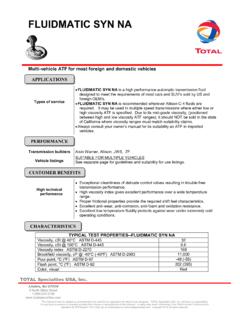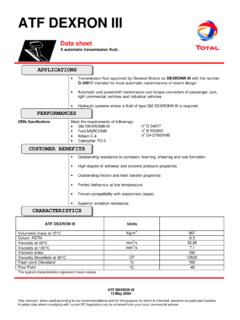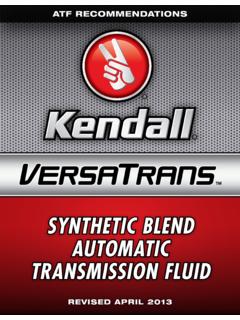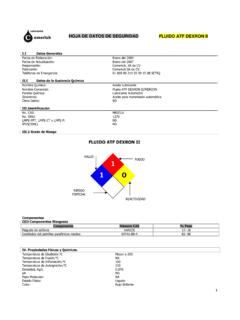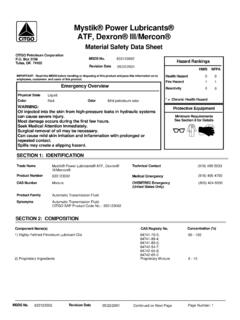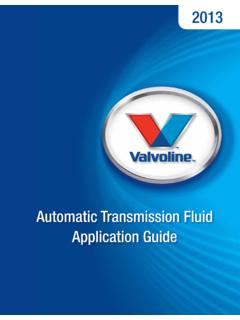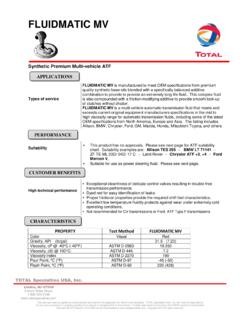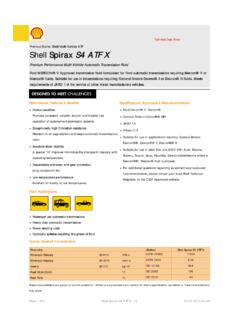Transcription of TOTAL FLUID NA H3 MSDS - Major Brands Oil
1 msds (Material Safety Data Sheet) TOTAL FLUID NA H3 Page 1 6/21/2011 SECTION #1 PRODUCT AND COMPANY IDENTIFICATION TRADE NAME: TOTAL FLUID NA H3 CHEMICAL NAME AND SYNONYMS: MIXTURE MANUFACTURER/SUPPLIER S NAME: TOTAL LUBRICANTS CANADA INC. 220, LAFLEUR LASALLE.
2 QUEBEC H8R 4C9 Tel.: (514) 595-7579 or 1-800-463-3955 24 HOURS EMERGENCY: Call CHEMTREC 1-800-424-9300 or 703-527-3887 PRODUCT USE: Lubricant atf dexron iii / MERCON. WHMIS CLASS AND DESCRIPTION - This product is not regulated by the WHMIS.
3 SECTION #2 COMPOSITION/INFORMATION ON INGREDIENTS NOM % No CAS --- -- --- ADDITIONAL REGULATORY INFORMATION - No hazardous ingredients as defined by the Canadian Hazardous Products Act (BILL C70) or by OSHA 29 CFR - Canadian DSL status: All ingredients are listed.
4 * No components of this product have been found carcinogenic or potential carcinogen. Does not contain ingredients that are listed as carcinogenic or potential carcinogen by OSHA, IARC or the National Toxicology Program (NTP). This product or its components have no teratogenic or mutagenic effects known. TOTAL FLUID NA H3 Page 2 6/21/2011 SECTION #3 PHYSICAL DATA PHYSICAL STATE AT 25 C Liquid BOILING POINT: 260 C DENSITY (g/cm3 at 15 C): 0,86 to 0,87 VAPOR PRESSURE (mm Hg at 20 C): Negligible VISCOSITY (cSt at 100 C): 6,8 to 7,4 EVAPORATION RATE: Negligible SOLUBILITY IN WATER: Negligible APPEARANCE ET ODOR: Red with characteristic odor.
5 SECTION #4 STABILITY AND REACTIVITY STABILITY: Stable CONDITIONS TO AVOID: Avoid excessive heat, open flames and formation of oil mist. PRODUCTS TO AVOID: Oxidizing agents, strong acids and bases. HAZARDOUS DECOMPOSITION PRODUCTS: N/A POLYMERIZATION: Will not occur SECTION #5 FIRE FIGHTING MEASURES FLASH POINT (COC): > 180 C FLAMMABILITY LIMITS IN AIR: LEL: N/A (% PER VOLUME) UEL: N/A AUTOIGNITION TEMPERATURE ( C): Not available EXTINGUISHING MEDIA: Foam, Dry chemical and CO2 HAZARDOUS COMBUSTION PRODUCTS: Normal combustion products, CO and CO2.
6 SPECIAL FIRE FIGHTING PROCEDURES: Do not enter confined fire space without adequate protective clothing and an approved positive self-contained breathing apparatus. Use water to cool fire exposed containers. TOTAL FLUID NA H3 Page 3 6/21/2011 SECTION #6 TOXICOLOGICAL INFORMATION SPECIES LD50 ORAL LD50 DERMAL LC50 INHALATION HRS Rat > 5000 mg/Kg > 2000 mg/Kg N/A --- INHALATION: Prolonged exposure to high vapor concentration of this product can cause headache, dizziness and nausea. Short-term overexposure can cause an irritation to the respiratory passages.
7 Exposure limit to the mist = 5 mg/m3 (TLV/TWA, ACGIH). CONTACT WITH EYES: May cause eye irritation. SKIN CONTACT: This product should not cause skin irritation. Prolonged and repeated contact with this product can cause skin drying, which may result in skin irritation and dermatitis. INGESTION: May cause nausea. SECTION #7 ACCIDENTAL RELEASE MEASURES SPILL AND LEAK PROCEDURES: Eliminate all ignition sources. Stop leak only if safe to do so. Absorb residue or small spills with absorbent material and remove to non-leaking containers for disposal.
8 SECTION #8 HANDLING AND STORAGE STORAGE AND HANDLING: Store in cool, dry, ventilated area, away from heat and ignition sources. Use good personal hygiene. Always keep the container close. SECTION #9 EXPOSURE CONTROLS / PERSONAL PROTECTION VENTILATION: Mechanical ventilation is recommended. RESPIRATORY PROTECTION: If mist present, chemical cartridge respirator is recommended. GLOVES: Resistant gloves (Viton, nitrile, Neoprene) are recommended when handling this material. EYE PROTECTION: Chemical safety goggles are recommended. OTHER PROTECTION: In confined spaces or where the risk of skin exposure is higher, resistant clothing or apron should be worn.
9 TOTAL FLUID NA H3 Page 4 6/21/2011 SECTION #10 DISPOSAL CONSIDERATIONS WASTE DISPOSAL METHODS: Consult relevant local authorities. Reclaim or dispose of at a licensed waste disposal company. Incinerate with approval of appropriate local authority. SECTION #11 FIRST AID INHALATION: Remove person to fresh air. See a physician if irritation persists. CONTACT WITH EYES: Flush immediately with water for at least 15 minutes. CONTACT WITH SKIN: Wash contaminated skin with mild soap and water. See a physician if irritation persists.
10 INGESTION: This product has a low toxicity. May cause nausea and have a laxative effect. Do not induce vomiting. Contact an Anti-Poison Center (1-800-463-5060). SECTION #12 HAZARDS IDENTIFICATION INHALATION: Prolonged exposure to high vapor concentration of this product can cause headache, dizziness and nausea. Short-term overexposure can cause an irritation to the respiratory passages. Exposure limit to the mist = 5 mg/m3 (TLV/TWA, ACGIH). CONTACT WITH EYES: May cause eye irritation. SKIN CONTACT: This product should not cause skin irritation.
